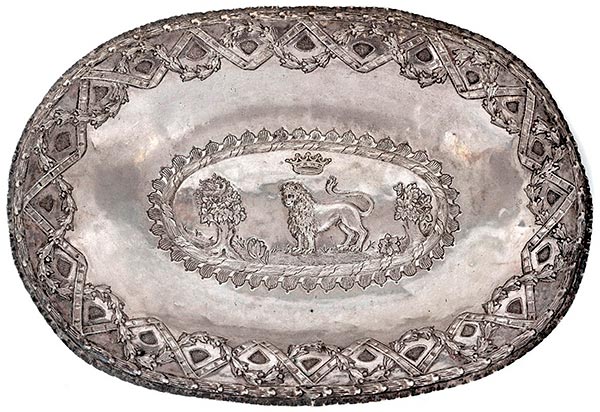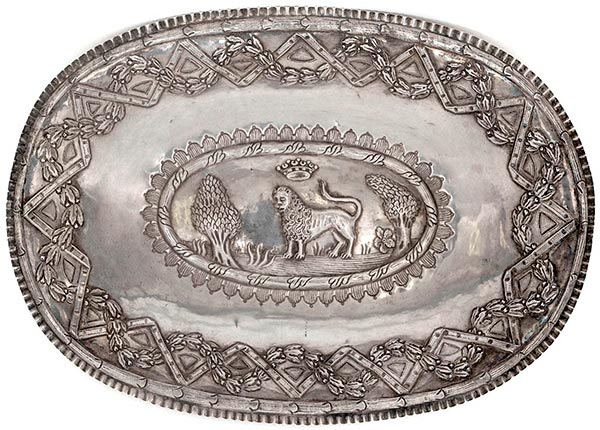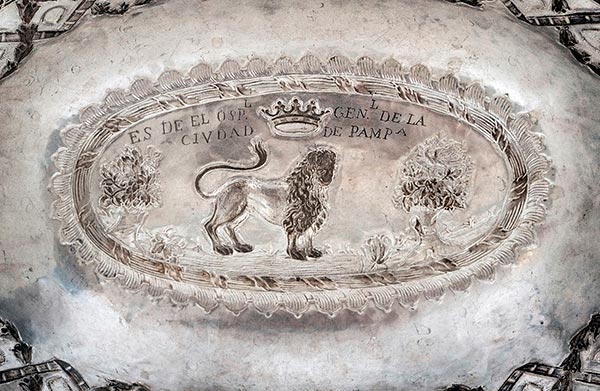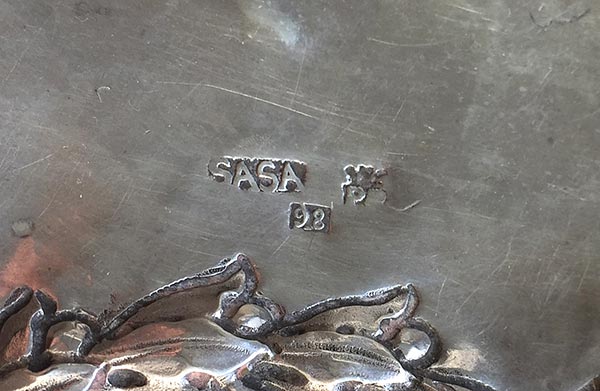The piece of the month of September 2021
HOSPITAL OF PAMPLONA MADE BY PEDRO ANTONIO SASA IN 1798.
Ignacio Miguéliz Valcarlos
Chairof Navarrese Heritage and Art
University of Navarra
Some pieces with a special significance for this institution have recently been added to the collection of the Museum of Navarre, since they link the collection with the original use for which the building was created, the General Hospital of Our Lady of Mercy of Pamplona. Indeed, it was in the first half of the 16th century when Don Ramiro de Goñi, archdeacon of the Table of the Cathedral of Pamplona, made a donation of part of his assets for the construction of a hospital that, in line with what other cities were doing, would unify the existing ones in Pamplona. This hospital remained under board of trustees of the Pamplona City Council and was open until 1932, when it was incorporated into the new Hospital of Navarra, which began to be built in 1906 thanks to the patronage of Doña Concepción Benítez. As patron of the Hospital, the City Council was in charge of its management and maintenance, and it is in this context that we must include the execution of four silver trays, made in 1798 by the silversmith Pedro Antonio de Sasa with the heraldic arms of the city. After the incorporation of the Hospital of Navarra, these works were moved to the new building, where they were used by the religious congregation that attended to the sick, being delivered by the last nuns to the management of the Hospital after their departure in 2020, who in turn deposited them for their conservation in the Museum of Navarra. Thus, almost 225 years later, these four trays return to the building to which they were destined, although on this occasion, with a different function.

Azafate (CE002835). Pedro Antonio de Sasa. 1798. Museum of Navarre Collection (Pamplona). Photograph: José Luis Larrión.
The four saucers follow the same compositional outline , of oval profile and straight edge, with a border composed of a double border, the wavy exterior and the mixtilinear interior, articulated by a rhomboidal fillet formed by a die-cut ribbon, imitating a chain, which is intertwined with a vegetal garland, and that inscribe triangular bodies in its interior. This border sample is identical to the one that appears on the border of the tray drawn by Francisco Iturralde in 1792 as an examination piece to obtain the degree scroll of master silversmith. The field follows, smooth concave, and the emblem, convex and with an oval central button, framed by a convex molding of rods tied together, surrounded by a border of grooved gallons in a fan. The surface of the emblem is occupied by a naturalistic and symbolic scene, a lion passing through with a crown, the heraldic arms of Pamplona, set in a landscape of vegetation, with two trees on either side. On the reverse, framing the crown, is the registration, in capital letters, "ES DE EL OSPL GENL DE LA CIVDAD DE PAMPA". As we have already said, the only difference we see between these four works is in the execution of the landscape, the lion and the crown, which although they follow the same plastic treatment, disposition and issue of elements in the four cartouches, they change in terms of their elaboration.

Azafate (CE002837). Pedro Antonio de Sasa. 1798. Museum of Navarre Collection (Pamplona). Photograph: José Luis Larrión.
The four trays have the triple markings required in Pamplona at this time: locality, author and date. The first, a double crowned P, corresponds to the capital of Navarre, being the third of the variants used throughout the seventeenth century; the second, 98, refers to the year of execution of the pieces, 1798; and the third, SASA, is the author's stamp, belonging to the Pamplona silversmith Pedro Antonio de Sasa (1745-1831). This artisan was a member of a dynasty of masters who dominated the silversmithing scene in Pamplona throughout the 19th century. Son of the silversmith Gregorio de Sasa, born in Barasoain but a resident of Logroño, he trained in Pamplona with José de Yabar, first for six years as an apprentice, and then for another four years as a journeyman. He obtained the degree scroll as a silversmith in 1775, for which he presented the drawing of a bowl, the other two pieces he was given to choose from being a French-style pitcher and a basin. In 1772 he married Victoria Planillo, niece of his master's wife, Joaquina Redín, whom they had proahijado, since they had no children. The new couple settled next to Yabar, taking care of his store and clientele, one of the most prestigious of the time in the city, inheriting everything at his death in 1777, which placed him in an unbeatable position to face the eighteenth century. In 1796, the city council of Pamplona chose him, together with Francisco Iturralde and with a salary of twenty-five ducats, to accompany the silversmith Manuel de Montalbo in his position of marker, for which he was given in custody one of the three keys of the chest where the seal of the city and the instruments to mark the silver were kept. Pedro Antonio's son was Vicente Sasa, also a silversmith, who we believe would have been trained alongside his father and who obtained the degree scroll master in 1807, choosing as his exam piece an azafate with decoration of plant motifs.

Saffron (CE002835). Reverse. Pedro Antonio de Sasa. 1798. Museum of Navarre Collection (Pamplona). Photograph: José Luis Larrión.
The trays studied here were not the only pieces of this subject that Pedro Antonio de Sasa made. As we have already mentioned, in his examination for master silversmith in 1775, he made a tray, whose drawing is preserved in the Libro de dibujos antiguos de los plateros de Pamplona, in which the drawings made as test of examination by the aspiring silversmiths of Pamplona are collected. It has a mixtilinear oval profile , with a convex border and concave field, both unstructured thanks to the variegated decoration of opposing and confronting C's, vegetal garlands and fan-shaped rockeries that cover them, and that frame the central button where a historical scene of a knight spearing a lion is inserted. The work of this silversmith is also the work of a tray from the church of San Nicolás de Pamplona, carved in 1797, a year before the pieces he made for the Hospital. It depicts the martyrdom of St. Nicholas, and curiously follows the same articulation as those studied here, although with a different decorative treatment, and also has on the back a registration of ownership arranged in a similar way to those in the pieces of the Hospital.

Azafate (CE002835). Marks. Pedro Antonio de Sasa. 1798. Museum of Navarre Collection (Pamplona). Photograph: Ignacio Miguéliz.
The azafate is a fully fashionable typology in Pamplona in the seventeenth century, as evidenced by its inclusion among the works to be chosen by those aspiring to obtain the Degree of master silversmith in the Ordinances of 1743: "A long azafate carved in foliage and flowers, in the middle a half-relief story, weighing twenty-six ounces, a little more or less". In fact, this is the typology with the greatest representation in the Book of ancient drawings of the silversmiths of Pamplona, since it was chosen on nineteen occasions. Thanks to this we can see the evolution it underwent throughout the seventeenth century in terms of the decoration of the emblem, which went from vegetal elements in the first half to the representation of stories in the second; while structurally they maintained the same form throughout the century, with an extended oval profile , straight border, concave field, sometimes with these two bodies joined together, and emblem with decoration. There are several works of this subject that have survived to the present day, both in civil and religious institutions as well as in private collections. To the first ones correspond two saucers conserved in the Museum of Navarre, carved by Lorenzo Laoz and José Ochoa respectively, to which are added the four studied here.
SOURCES AND BIBLIOGRAPHY
ARRÚE UGARTE, B., La platería logroñesa, Logroño, high school de programs of study Riojanos, 1981.
GARCÍA GAINZA, M.ª C., Dibujos antiguos de los plateros de Pamplona, Pamplona, University of Navarra, 1991.
GARCÍA GAINZA, Mª. C. et al., Catalog Monumental de Navarra. Merindad de Pamplona. Volume V***, Pamplona, Government of Navarra - Archbishopric of Pamplona - University of Navarra, 1998.
MIGUÉLIZ VALCARLOS, I., "Azafate de plata de José de Yabar", in classroom Abierta, web page of the Chair de Patrimonio y Arte Navarro, February 2008.
MIGUÉLIZ VALCARLOS, I., "Azafates pamploneses de la segunda mitad del siglo XVIII", in Príncipe de Viana, nº 244, Pamplona, 2008, pp. 339-376.
MORALES SOLCHAGA, E., Gremios artísticos en Pamplona durante los siglos del Barroco, Pamplona, Gobierno de Navarra, 2015.
ORBE SIVATTE, M., Platería en el taller de Pamplona en los siglos del Barroco, Pamplona, Government of Navarra, 2008.
